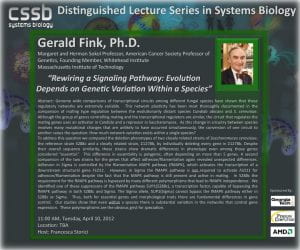 Distinguished Lecture Series Guest Speaker: Gerald E. Fink
Distinguished Lecture Series Guest Speaker: Gerald E. Fink
Margaret and Herman Sokol Professor
American Cancer Society Professor of Genetics
Member, Whitehead Institute
Massachusetts Institute of Technology
Date & Time: Tuesday, April 10, 2012, 11:00AM
Location: Klaus 1116E
Host: Francesca Storici
Abstract: Genome wide comparisons of transcriptional circuits among different fungal species have shown that these regulatory networks are extremely variable. This network plasticity has been most thoroughly documented in the comparison of mating type regulation between the evolutionarily distant species Candida abicans and S. cerevisiae. Although the group of genes controlling mating and the transcriptional regulators are similar, the circuit that regulates the mating genes uses an activator in Candida and a repressor in Saccharomyces. As this change in circuitry between species involves many mutational changes that are unlikely to have occurred simultaneously, the conversion of one circuit to another raises the question: How much network variation exists within a single species? To address this question we compared the deletion phenotypes of two closely related strains of Saccharomyces cerevisiae, the reference strain S288c and a closely related strain, Σ1278b, by individually deleting every gene in Σ1278b. Despite their overall sequence similarity, these strains show dramatic differences in phenotype even among those genes considered “essential.” This difference in essentiality is polygenic, often depending on more than 5 genes. A second comparison of the two strains for the genes that affect adhesion/filamentation again revealed unexpected differences. Adhesion in Sigma is controlled by the filamentation MAPK pathway (fMAPK), which activates the transcription of a downstream structural gene FLO11. However, in Sigma the fMAPK pathway is not required to activate FLO11 for adhesion/filamentation despite the fact that the MAPK pathway is still present and active in mating. In S288c the requirement for the fMAPK pathway is bypassed by many different polymorphisms that lead to fMAPK independence. We identified one of these suppressors of the fMAPK pathway SUP1(S288c), a transcription factor, capable of bypassing the fMAPK pathway in both S288c and Sigma. The Sigma allele, SUP1(Sigma) cannot bypass the fMAPK pathway either in S288c or Sigma. Thus, both for essential genes and morphological traits there are fundamental differences in gene control. Our studies show that even within a species there is substantial variation in the networks that control gene expression. These polymorphisms are the obvious grist for speciation.
Additional Info: Gerry Fink developed baker’s yeast as a model for studying the fundamental biology of all organisms. Fink’s creative use of classical genetics, biochemistry, and molecular biology has yielded numerous discoveries in biology. His lab has pioneered a better understanding of gene regulation, mutation, and recombination.
Faculty Profile
Profile: Whitehead Institute
